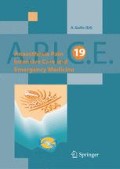Conclusions
It is quite impossible to force a diseased lung to comply to a constant high flow-rate of gas, and expect optimal alveolar distribution. Ideally, the medical respirator must have a flow-variable function, served by the back pressure as pulmonary structures are dilated by the inspiratory pressure producing the proximal-distal flow gradient into the lung.
Therefore, the development of ventilation and oxygen-exposure strategies to minimise lung injury is a priority for improving patient outcome. Moreover, good knowledge in basic pathophysiology remains the cornerstone to enable clinicians to design strategies with the aim of improving the management of patient-ventilator interaction.
Access this chapter
Tax calculation will be finalised at checkout
Purchases are for personal use only
Preview
Unable to display preview. Download preview PDF.
References
Donn SM, Sinha SK (2002) Newer techniques of mechanical ventilation: an overview. Seminars in neonatology. 401–407
Jobe AH, Bancalari E (2001) Bronchopulmonary dysplasia. Am J Resp Crit Care Med 163:1723–1729
Bernstein G, Mannino F, Heldt GP et al (1996) Randomized multicenter trial comparing synchronized and conventional intermittent mandatory ventilation in neonates. J Pediatr 128(4):453–463
Greenough A (2001) Update on patient-triggered ventilation. Clin Perinatol 28(3):533–546
Bandy KP, Nick JJ, Donn SM (1992) Volume-controlled ventilation for severe neonatal respiratory failure. Neonatal intensive care 5(3):70–73
Clark RH, Gerstmann DR (1998) Controversies in high-frequency ventilation. In: Clinics in perinatology. Saunders, Philadelphia 25:113–121
Meredith KS, deLemos RA, Coalson JJ (1989) Role of lung injury in the pathogenesis of hyaline membrane disease in premature baboons. J Appl Physiol 66:2150–2158
Courtney SE, Durand DJ, Asselin JM et al (2002) High-frequency oscillatory ventilation versus conventional mechanical ventilation for very-low-birth-weight infants. N Engl J Med 347:643–652
Gerstmann DR, Minton SD, Stoddard RA et al (1996) The Provo multicenter early high-frequency oscillatory ventilation trial. Improved pulmonary and clinical outcome in respiratory distress syndrome. Pediatrics 98:1044–1057
HIFI Study Group (1989) High frequency oscillatory ventilation compared with conventional mechanical ventilation in the treatment of respiratory failure in preterm infants. N Engl J Med 320:88–93
HIFO Study Group (1993) Randomized study of high-frequency oscillatory ventilation in infants with severe respiratory distress syndrome. J Pediatr 122:609–619
Johnson AH, Peacock JL, Greenough A et al (2002) High-frequency oscillatory ventilation for the prevention of chronic lung disease of prematurity. N Engl J Med 347:633–642
Keszler M, Houchang DM, Brudno DS et al (1997) Multicenter controlled clinical trial of high-frequency jet ventilation in preterm infants with uncomplicated respiratory distress syndrome. Pediatrics 100:593–599
Author information
Authors and Affiliations
Editor information
Editors and Affiliations
Rights and permissions
Copyright information
© 2005 Springer-Verlag Italia
About this paper
Cite this paper
Bougatef, A. (2005). Neonatal Mechanical Ventilation. In: Gullo, A. (eds) Anaesthesia, Pain, Intensive Care and Emergency Medicine — A.P.I.C.E.. Springer, Milano. https://doi.org/10.1007/88-470-0351-2_7
Download citation
DOI: https://doi.org/10.1007/88-470-0351-2_7
Publisher Name: Springer, Milano
Print ISBN: 978-88-470-0288-3
Online ISBN: 978-88-470-0351-4
eBook Packages: MedicineMedicine (R0)

